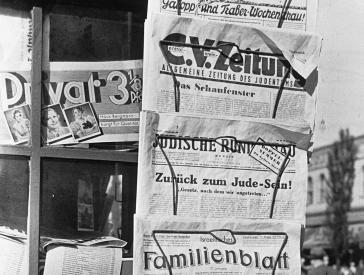Tonalities. Jewish Women Ceramicists from Germany after 1933
Press Information
Press Release, Thu 10 Oct 2013
The exhibition "Tonalities. Jewish Women Ceramicists from Germany after 1933" focuses on four women who belonged to the avant-garde of German art ceramics in the 1920s:
- Margarete Heymann-Loebenstein, remarried as Margarete Marks (1899-1990)
- Hedwig Grossmann (1902-1998)
- Hanna Charag-Zuntz (1915-2007)
- Eva Samuel (1904-1989)
- Kontakt
-
Press office
T +49 (0)30 259 93 419
presse@jmberlin.de
- Address
Jewish Museum Berlin Foundation
Lindenstraße 9–14
10969 Berlin
As a contribution to the Berlin Theme Year "2013 – Diversity Destroyed" this exhibition of the Jewish Museum Berlin traces and illustrates the artistic and professional development of these women in their exile: As Jewish artists they were no longer able to work creatively in Germany after the National Socialist took power. Between 1932 and 1940, they emigrated to Great Britain and Palestine. Oscillating between a spirit of optimism and disappointments, the artists were able to find new beginnings in their exiles. A selection of more than 60 pottery works for both daily and ritual use shows how, in their struggle to find a new creative identity, the women were able to develop new and timeless forms of expression in ceramics design.
"I spent several years studying various sources of information to trace the life stories of these women. Thus, the exhibition does not only focus on the artistic quality of their works. The pieces also have a historical value. They show the life paths of the ceramicists which started in Germany in the 1920s," Michal Friedlander, curator of the exhibition, explains.
A new beginning in England
Margarete Heymann-Loebenstein, who became Margarete Marks in her second marriage, was from Cologne. In 1923 she founded the successful Haël Ceramic Workshop in Velten, approximately 40 kilometers north of Berlin. Her designs are characterized by daring modern forms, abstract decorations and bright glazes. After the National Socialists denounced her for "subversive activities" in 1933, she sold her workshop well below its value to a member of the NSDAP. Young Hedwig Bollhagen was made new artistic director of the workshop. In 1935, an antisemitic paper published an article that compared the designs of Bollhagen and Heymann-Loebenstein and defamed the forms produced by Haël as "degenerate". One of the teapots used to illustrate the article is shown in the exhibition. In 1936, Margarete Heymann-Loebenstein left Germany. The exhibition follows her to England, where she tried to re-establish herself with new ceramic products under the label of "Greta-Pottery". However, she was not able to replicate the success she had had in Germany.
A new beginning in Palestine
Hedwig Grossmann from Berlin, Hanna Charag-Zuntz from Hamburg and Eva Samuel from Essen are considered the founding mothers of modern Israeli art ceramics. They arrived in Palestine between 1932 and 1940. Trained in Germany, they were highly skilled and technically adept. Moreover, they had sharp visual sensibilities, a strong sense of determination and the willingness to address the challenges of life in the Middle East. As refugees and pioneers the three artists developed new traditions of art ceramics in Palestine and Israel.
Hedwig Grossmann moved to Haifa and – while looking for clay and other raw materials – took up geological research. She worked only with materials that she found in the area and baked her pieces in a wood-fired oven that she had built herself. She created works without ornaments and only rarely used glazing. Inspired by Middle Eastern forms of ceramics and archeological findings she was looking for a new artistic language based on local traditions. Her works impress with their powerful silhouettes and their flawless craftsmanship.
Hanna Charag-Zuntz was intrigued by the forgotten Roman pottery method "Terra Sigillata". With her masterful and exceptional skill she was able to revive the Terra Sigillata technique. She worked with thin layers of clay and fired those at very high temperatures, a method that allowed her to create shimmering surfaces without using glazes or glass firing. Her techniques were lost when she died.
Eva Samuel initially found a job in a small ceramics manufactory in Jerusalem where people worked with very simple methods. The artist began to create folkloristic figurines inspired by the different ethnic groups that she met in Palestine. These statues sold well in craft shops in Jerusalem. Soon she opened her own workshop in Rischon Le-Zion, together with Paula Ahronson. Despite the high cost, she imported glazing material from Germany. To get her hands on higher-quality clay, she often endured long trips with a horse cart. In their workshop the two women produced household pottery such as jugs, vases and bowls in traditional European designs. When painting her works, Eva Samuel – who had started her career as a painter – chose motives and designs from her new environment.
| Exhibition dates | 10 October 2013 to 9 February 2014 |
|---|---|
| Where | Libeskind Building, basement, Rafael Roth Learning Center |
| Admission | with the museum ticket |
An exhibition in connection with the Berlin Theme Year "Diversity Destroyed"
Exhibition website and video with further information on the exhibition: www.jmberlin.de/tonalities




